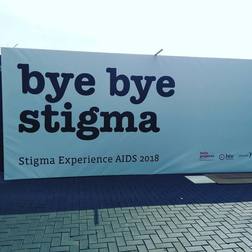
More than 16,000 researchers, advocates, policy makers, funders and community leaders from more than 160 countries came together in Amsterdam for the 22nd International AIDS Conference (AIDS 2018). They are all committed to achieving a world free from HIV. These are the main takeaways:
 AIDS2018 Banner. Photo: Patrick Reyntiens
AIDS2018 Banner. Photo: Patrick Reyntiens Prioritise prevention
Prevention was top of the agenda. Dozens of sessions looked at the results of basic studies, clinical research as well as research with real-world implications for implementation and practice. Whereas PrEP (Pre-exposure prophylaxis), the HIV prevention strategy that uses antiretroviral drugs to protect HIV-negative people from HIV infection, received a lot of attention, there was new data from vaccine trials and extended results from the PARTNER 2 study in MSM couples that added still more evidence that when it comes to HIV, U=U (undetectable = untransmittable).
Yet, with an estimated 1.8 million new HIV infections in 2017, there was widespread agreement at AIDS 2018 that the current pace of scale up for proven prevention initiatives is far too slow to reach future targets and must be increased rapidly to make lasting gains to combat the epidemic.
Face the gap in the AIDS response
No AIDS response can be ensured without proper funding though. New data released at AIDS 2018 reveal a significant US$6 billion gap between what is available for the response and what is needed now to ensure global access to prevention, treatment and care.
After several years of flat funding, more than half of major donor governments decreased their HIV commitments in 2017, and no new significant commitments have been forthcoming. Treatment scale up has plateaued and is well short of what is needed to meet UNAIDS 2020 treatment goals.
While domestic spending on HIV has risen significantly in recent years, it is not enough to make up for the growing gaps in donor funding. With nearly 1 million people still dying of HIV annually, advocates warn that if the funding gap is not closed soon, the shortfall could lead to millions of unnecessary HIV infections and deaths.
Stand up against HIV criminalisation
The conference also paid particular attention to Eastern Europe and Central Asia, where the number of new HIV diagnoses doubled over the past years. Stigma and discrimination are major drivers of the epidemic in the region, where one-third of new HIV infections are among people who inject drugs. AIDS 2018 provided a high-profile platform for researchers and advocates from the region addressing innovation around HIV and substance use, advances in harm reduction and drug policy and the human rights of people from key populations.
HIV criminalisation is a growing concern in the EECA region, as well as in other parts of the world where legal systems criminalise HIV non-disclosure, exposure or transmission, even in cases when there is no possibility of HIV transmission. An Expert Consensus Statement by 20 leading HIV scientists and an accompanying editorial published this week in the Journal of the International AIDS Society (JIAS) systematically and scientifically refuted the rationale for these laws, and gave advocates and experts a new tool against the stigma and injustice of HIV criminalisation.
Prevention was top of the agenda. Dozens of sessions looked at the results of basic studies, clinical research as well as research with real-world implications for implementation and practice. Whereas PrEP (Pre-exposure prophylaxis), the HIV prevention strategy that uses antiretroviral drugs to protect HIV-negative people from HIV infection, received a lot of attention, there was new data from vaccine trials and extended results from the PARTNER 2 study in MSM couples that added still more evidence that when it comes to HIV, U=U (undetectable = untransmittable).
Yet, with an estimated 1.8 million new HIV infections in 2017, there was widespread agreement at AIDS 2018 that the current pace of scale up for proven prevention initiatives is far too slow to reach future targets and must be increased rapidly to make lasting gains to combat the epidemic.
Face the gap in the AIDS response
No AIDS response can be ensured without proper funding though. New data released at AIDS 2018 reveal a significant US$6 billion gap between what is available for the response and what is needed now to ensure global access to prevention, treatment and care.
After several years of flat funding, more than half of major donor governments decreased their HIV commitments in 2017, and no new significant commitments have been forthcoming. Treatment scale up has plateaued and is well short of what is needed to meet UNAIDS 2020 treatment goals.
While domestic spending on HIV has risen significantly in recent years, it is not enough to make up for the growing gaps in donor funding. With nearly 1 million people still dying of HIV annually, advocates warn that if the funding gap is not closed soon, the shortfall could lead to millions of unnecessary HIV infections and deaths.
Stand up against HIV criminalisation
The conference also paid particular attention to Eastern Europe and Central Asia, where the number of new HIV diagnoses doubled over the past years. Stigma and discrimination are major drivers of the epidemic in the region, where one-third of new HIV infections are among people who inject drugs. AIDS 2018 provided a high-profile platform for researchers and advocates from the region addressing innovation around HIV and substance use, advances in harm reduction and drug policy and the human rights of people from key populations.
HIV criminalisation is a growing concern in the EECA region, as well as in other parts of the world where legal systems criminalise HIV non-disclosure, exposure or transmission, even in cases when there is no possibility of HIV transmission. An Expert Consensus Statement by 20 leading HIV scientists and an accompanying editorial published this week in the Journal of the International AIDS Society (JIAS) systematically and scientifically refuted the rationale for these laws, and gave advocates and experts a new tool against the stigma and injustice of HIV criminalisation.

 RSS Feed
RSS Feed